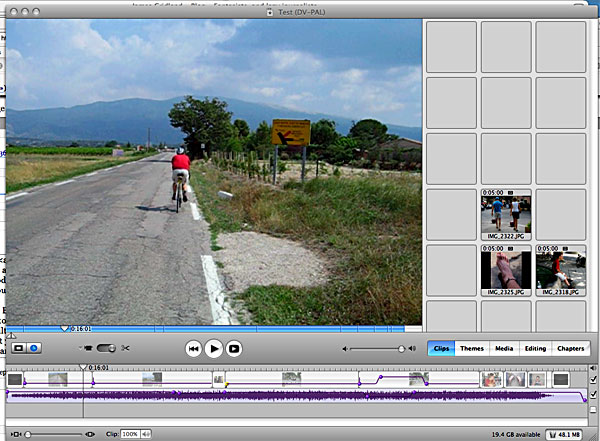Invaluable tool when writing business plans. Find it here.
Category Archives: Technology
The risks of biotechnology

Denise Caruso has published an interesting book on the subject.
At last! Someone who is as sceptical about Twitter as I am
Nice post — Is Twitter TOO good? — by Kathy Sierra. In her concluding para of a long and thoughtful post, she writes:
I am not in the target audience for Twitter–I am by nature a loner. I don’t want to be that connected. And I also have a huge appreciation for the art of keeping the mystery alive. I don’t want to know that much about so many people, and I sure don’t want people to know that much about me… mundane or otherwise. So, that puts me in the minority, and my Twitter fears are probably based solely on my own–quirky and less common–personality traits.
Lots more like you, Kathy.
Update… Disturbing news — Kathy has had death threats, and is understandably freaked by them. She pulled out of ETech (where she was due to give a presentation) as a result.
ConceptShare
Collaborative work is hard — and even harder when you have to do it online. So ConceptShare is an interesting idea — described as “Web-Based Idea and Design Sharing and Collaboration”. I can see lots of industrial applications for it.
Back to Basics
Stanford has launched an intriguing new project — Clean Slate Design for the Internet.
We believe that the current Internet has significant deficiencies that need to be solved before it can become a unified global communication infrastructure. Further, we believe the Internet’s shortcomings will not be resolved by the conventional incremental and ‘backward-compatible’ style of academic and industrial networking research. The proposed program will focus on unconventional, bold, and long-term research that tries to break the network’s ossification. To this end, the research program can be characterized by two research questions: “With what we know today, if we were to start again with a clean slate, how would we design a global communications infrastructure?”, and “How should the Internet look in 15 years?” We will measure our success in the long-term: We intend to look back in 15 years time and see significant impact from our program.
In the spirit of past successful inter-disciplinary research programs at Stanford, the program will be driven by research projects ‘from the ground up’. Rather than build a grand infrastructure and tightly coordinated research agenda, we will create a loosely-coupled breeding ground for new ideas. Some projects will be very small, while others will involve multiple researchers; our goal is to be flexible, creating the structure and identifying and focusing funds to support the best research in clean-slate design.
Multitasking: bad idea
Be warned! The New York Times reports that multitasking is bad for you.
Several research reports, both recently published and not yet published, provide evidence of the limits of multitasking. The findings, according to neuroscientists, psychologists and management professors, suggest that many people would be wise to curb their multitasking behavior when working in an office, studying or driving a car.
These experts have some basic advice. Check e-mail messages once an hour, at most. Listening to soothing background music while studying may improve concentration. But other distractions — most songs with lyrics, instant messaging, television shows — hamper performance. Driving while talking on a cellphone, even with a hands-free headset, is a bad idea.
In short, the answer appears to lie in managing the technology, instead of merely yielding to its incessant tug.
“Multitasking is going to slow you down, increasing the chances of mistakes,” said David E. Meyer, a cognitive scientist and director of the Brain, Cognition and Action Laboratory at the University of Michigan. “Disruptions and interruptions are a bad deal from the standpoint of our ability to process information.”
Still movies
Further to my reflections on getting movies from digital still cameras, here’s an example of the way the boundaries between devices is blurring. My Canon IXUS, like many compact digital cameras, has a movie mode. If you use it to record movie clips, then iPhoto neatly collects them and keeps them in its library, where they’re stored as .avi files. Double-click on a movie clip and OS X launches QuickTime player, enabling one to view the clip.
So far so good. But if you launch iMovieHD then you can drag .avi clips from the iPhoto library onto the editing timeline. The software converts them to DV on the fly. (In the old days, you had to open them in QuickTime Pro and convert them to DV files, but now it all seems to be built into iMovieHD.)

I’ve just tested this by making a complete little film from movie clips and images taken using the IXUS in Provence last year. It was as easy as pie. I’d post it to YouTube were it not for the fact that the soundtrack is from a Leo Kottke album and therefore not my property.
I’m sure you can do all this using Windows, but I’ll bet the tools aren’t as integrated as they are on OS X.
I should also add that it was Quentin who, unwittingly, started me off on this line of thought. He too has an IXUS.
Movies without a movie camera
Hmmm… From an Apple QuickTime marketing message:

The pocket-sized, innovative Casio EXILIM HI-ZOOM EX-V7 is currently the world’s slimmest digital camera with a 7X optical zoom lens. More than just a still camera, it also records widescreen, next-generation, high-quality H.264 movies — at remarkably small file sizes — with movie stabilizer technology that minimizes the effects of hand movement while filming. You can record up to three hours of video using a 2GB memory card.
If true, why bother carrying a camcorder? Current price: £279 from here.
OLPC: rethinking the user interface
The folks working on the One Laptop Per Child project have decided that they need to rethink the user interface to take into account the needs of the kids who are its target users. “The desktop metaphor is so entrenched in personal computer users’ collective consciousness”, they write,
that it is easy to forget what a bold and radical innovation the GUI was and how it helped free the computer from the “professionals” who were appalled at the idea of computing for everyone.
OLPC is about to shake up things once more.
Beginning with Papert’s simple observation that children are knowledge workers like any adult, only more so, we decided they needed a user-interface tailored to their specific type of knowledge work: learning. So, working together with teams from Pentagram and Red Hat, we created SUGAR, a “zoom” interface that graphically captures their world of fellow learners and teachers as collaborators, emphasizing the connections within the community, among people, and their activities.
Looking at the design principles underpinning the new interface it’s clear that the team are indeed embarking on a radical re-think. Michael got SUGAR running on Ndiyo terminals (see picture)…

… and although we can’t obviously replicate the mesh-networking facility that’s built into the OLPC laptop, we’ve been able to play with the software. It’s fascinating to be forced to unlearn the desktop metaphor that we’ve all absorbed since the Xerox days.
So IT matters, then?
The use of information technology was “the major driver” of economic growth over the past decade, adding $2 trillion a year to the economy, according to a report by the Information Technology and Innovation Foundation.
Fueled by “the phenomenal growth of computer power” since 2000, the use of IT has given new tools to businesses and improved productivity while controlling costs, said Rob Atkinson, a researcher and government adviser who heads the IT Foundation.
But the full impact of the “IT revolution” has not been recognized by government officials because of lingering skepticism from the dot-com boom the late 1990s and the bust that followed, he added. The 53-page report was an effort to catalog the IT industry’s impact.
Atkinson’s foundation is a think tank backed by such tech companies as Cisco Systems, IBM and eBay, and its goal is to push an “innovation agenda” in Washington. Atkinson said that doesn’t mean subsidies for specific industries but greater investment in research, use of the tax code to spur investment and “do no harm” policies that don’t hinder growth.
Hmmm… Full report is here. I bet Nick Carr has something to say about this. After all, he shot to fame with a sceptical book entitled Does IT Matter?. Just checked his blog [23:50 on 14.03.2007]. Nothing.
